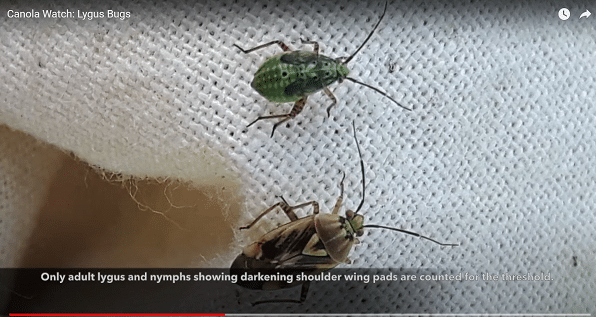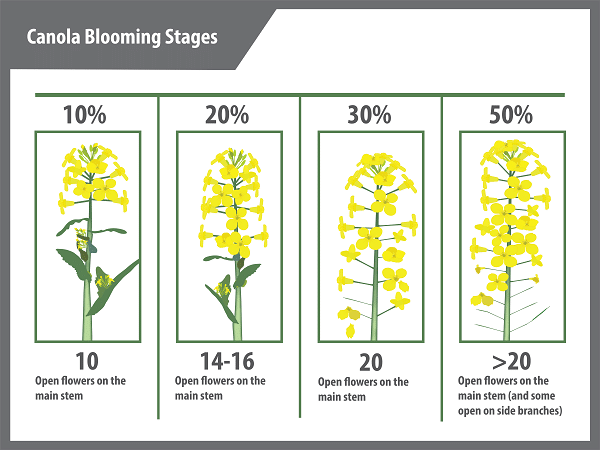
Do your research before using heat-fighting products
Canola does not handle extreme heat well. With temperatures into the 30s across the Prairies, growers are looking for anything that might mitigate heat stress. However, buyer beware: there are companies claiming their products can reduce heat stress in canola, but these may not necessarily be a fit for your farm. Your best bet is to use good data, independently verified across several years and environments to evaluate products; this article provides some key tips on how to critically assess the potential for product efficacy before investing in an unfamiliar product. For more information on the impact of heat on canola, see this Country Guide article and this Canola Encyclopedia section.
Boron benefits on canola inconclusive. Foliar-applied boron products have been reported to mitigate heat stress caused by high day and nighttime temperatures in crops such as rice. However, the data is inconclusive for canola. Trials conducted in western Canada on canola have shown little or no yield or economic benefit. There have been trials evaluating boron in Ontario on winter canola which found some benefit when foliar boron products were applied at flowering. In 33 replicated field trials, applications were economical 36 per cent of the time. Read the report here.
It is important to consider the fundamentals of plant physiology and the movement of nutrients in the environment when canola is under heat and drought stress. In the soil, boron moves via mass flow or with water. Further, boron has been reported to translocate via the phloem within the plant – a process requiring water.
In dry or drought conditions, the physiological mechanisms taking up boron and transporting it within the plant are not working efficiently due to lack of water. The variable results seen in the field may be a result of some boron moving through the plant when there is adequate soil moisture. However, when the plant is under drought stress boron is likely not taken up when applied as a foliar application and does not mitigate heat stress.
Results from a boron trial carried out through the Ultimate Canola Challenge are available here.
On-farm research trials can drive decision-making. Regardless of what product you are trying, the only guaranteed return is always to the point of sale, so leave check strips to determine if there was return on investment in the purchase for your farm.
If you want to try running a research trial on your farm, check out this article to set up a proper, robust trial. Remember that it is important to identify and leave several check strips that you can use to evaluate products at harvest. Never lose an opportunity to learn something on your farm!

Should I spray sclerotinia and when?
Sclerotinia stem rot prefers wet conditions; if you walk out of a canola stand with soaking wet pants, it is likely that there is disease pressure in your crop. However, this won’t be the case for many farmers in western Canada experiencing extremely hot, dry conditions right now. Still, if you suspect the presence of sclerotinia, now is the time to act. This video can help you make the decision to spray to control sclerotinia or not. Check out this video for tips on when best to spray for the disease. This Canola Encyclopedia article also offers valuable advice around fungicide timing.
A rule of thumb for spraying cabbage seedpod weevils
Farmers are asking a lot of questions about how to manage cabbage seedpod weevil this season. This article offers some key management tips. Keep in mind, however, that insect thresholds are often nominal thresholds or “educated estimates.” If you’re concerned the population might still be arriving in your field, hold off on spraying cabbage seedpod weevils until you find half-inch pods (the point where adult females can start to lay eggs in developing canola pods) on the plant stem. This, of course, requires scouting with a sweep net. Four sweep counts of 10 in two paired locations is likely sufficient to estimate whether or not the number of CSPW adults justifies control with a foliar insecticide. Check out the latest research on cabbage seedpod weevils here.
Tips for scouting and managing lygus bugs
No threshold exists for lygus bugs in a bolting crop but limited damage has been documented at this crop stage in canola. The end of flowering is the time to assess your field for the presence of lygus bugs. Scouting techniques for these canola pests can be found here while overall management strategies are available here. One important thing to remember is that even excessively high numbers of lygus very rarely require insecticide control at flowering. General information about lygus bugs is available in the video at the top of this page.
Moisture retention a feature of direct seeding/zero till practices
Direct seeding/zero till practices are meant — among other things — to preserve moisture in times of need. With dry, scorching temperatures throughout the Prairies, this is a good time to have some extra moisture on hand. Jason Casselman, a Canola Council of Canada agronomist based in northern Alberta, says the practice has definitely helped conserve moisture among the producers in his area who used it at seeding time, improving their yield potential in the process. Obviously, you can’t go back in time to change your tillage practices, but that doesn’t mean you can’t carefully weigh the pros and cons for next year. Consider tillage wisely presents the upsides and downsides of both tillage and reduced/zero tillage.
